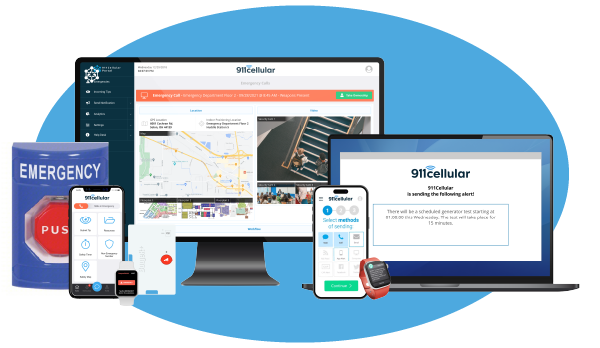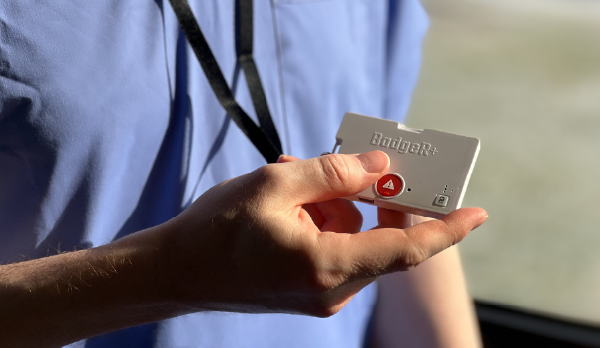Discover the must-have features of a safety app to keep you protected in any situation.
How Safety Apps Protect Staff in Hospital Settings
Safety apps play a crucial role in protecting staff in hospital settings. With the increasing number of incidents in healthcare facilities, it is essential to have a reliable safety app that can provide immediate assistance in case of emergencies. These apps often include features such as panic buttons, which allow staff members to quickly alert security or call for help. Additionally, safety apps can provide real-time location tracking, enabling security personnel to locate staff members who may be in danger or need assistance. By having a safety app, hospital staff can feel more secure and confident while carrying out their duties.
Another important feature of safety apps in hospital settings is the ability to send emergency alerts and notifications. In critical situations, such as an active shooter incident or a natural disaster, time is of the essence. Safety apps can send instant alerts to all staff members, informing them about the situation and providing instructions on what actions to take. This can help in minimizing confusion and ensuring a coordinated response from the entire hospital staff. Overall, safety apps are a valuable tool in safeguarding hospital staff and creating a safer working environment.
Safety Apps at Colleges, Universities & School Districts
Safety apps are not limited to hospital settings; they are also widely used in colleges, universities, and school districts. Educational institutions have a responsibility to ensure the safety and well-being of their students, faculty, and staff. Safety apps provide an effective means of enhancing security on campus and mitigating potential risks.
One of the key features of safety apps in educational settings is real-time location tracking. This allows campus security to monitor the whereabouts of students and staff and respond quickly in case of an emergency. Whether it’s a medical emergency, a threat on campus, or a natural disaster, safety apps can provide accurate location information to ensure a swift and targeted response.
Emergency alerts and notifications are another crucial feature of safety apps in colleges, universities, and school districts. In the event of a campus-wide emergency, such as an active shooter situation or a weather-related threat, safety apps can send instant alerts to all users, notifying them of the situation and providing instructions on how to stay safe. This rapid communication can help in preventing injuries and saving lives.
Moreover, safety apps can also be used for sending crime tips. Students and staff can anonymously report any suspicious activities or incidents they witness on campus through the app. This encourages a culture of vigilance and allows security personnel to take proactive measures to maintain a safe environment.
Safety check-ins and check-outs are additional features that are particularly useful in educational settings. Students and staff can use the app to check-in when they arrive on campus or enter a specific building, ensuring that their whereabouts are known. In case of an emergency or a missing person situation, this information can be crucial in locating individuals and initiating a swift response.
Lastly, safety apps offer customizable safety features to cater to the unique needs of each educational institution. Administrators can customize the app to include specific emergency protocols, campus maps, and important contact information. This ensures that users have access to the most relevant and up-to-date safety resources.
In conclusion, safety apps have become an indispensable tool in ensuring the safety and security of colleges, universities, and school districts. With features such as real-time location tracking, emergency alerts, crime reporting, safety check-ins, and customization options, these apps empower educational institutions to create a safer environment for their community.
Real-Time Location Tracking
Real-time location tracking is a vital feature of safety apps that offers numerous benefits. By utilizing GPS technology, safety apps can track the precise location of users in real-time, providing valuable information in emergency situations. This feature is especially useful for individuals who may find themselves in dangerous or unfamiliar environments, such as travelers or those walking alone at night.
With real-time location tracking, users can feel more secure knowing that their whereabouts are being monitored. In case of an emergency, such as a medical crisis or an incident of violence, safety apps can quickly alert authorities and provide them with the exact location of the user in distress. This enables a faster response time and increases the chances of a successful resolution.
Moreover, real-time location tracking can also be beneficial in non-emergency situations. For example, parents can use safety apps to keep track of their children’s whereabouts and ensure their safety. Similarly, employers can monitor the location of their employees who work remotely or travel frequently, enhancing their duty of care responsibilities.
Overall, real-time location tracking is a powerful feature that enhances personal safety and provides peace of mind in various contexts. By leveraging this technology, safety apps offer an added layer of protection for individuals in potentially risky situations.
Emergency Alerts and Notifications
Emergency alerts and notifications are a crucial aspect of safety apps that help keep users informed and safe during critical situations. Whether it’s a natural disaster, a security threat, or a medical emergency, receiving timely and accurate information is essential for making informed decisions and taking appropriate actions.
Safety apps can instantly send emergency alerts and notifications to all users, ensuring that they are aware of the situation and can respond accordingly. These alerts can include important details such as the nature of the emergency, recommended safety measures, and evacuation instructions. By providing clear and concise information, safety apps help prevent panic and confusion, enabling users to navigate through the crisis with confidence.
Furthermore, emergency alerts and notifications can be tailored to specific user groups or locations, allowing for targeted communication. This ensures that users receive relevant information based on their proximity to the emergency or their role within an organization. For example, in a university setting, alerts can be sent to specific buildings or departments that may be directly affected by an incident.
In addition to sending alerts, safety apps can also provide notifications about ongoing safety updates and reminders. This can include information about upcoming drills, changes in safety protocols, or general tips for staying safe in various situations. By keeping users informed on an ongoing basis, safety apps help foster a culture of preparedness and proactive risk management.
In conclusion, emergency alerts and notifications are a critical feature of safety apps that enhance situational awareness and enable users to respond effectively during emergencies. By providing timely and accurate information, these apps contribute to a safer and more resilient community.
Sending Crime Tips
Safety apps offer the valuable feature of sending crime tips, empowering individuals to play an active role in maintaining public safety. By allowing users to report suspicious activities or incidents they witness, these apps create a platform for anonymous reporting and encourage community involvement in crime prevention.
One of the key benefits of sending crime tips through a safety app is the ability to provide information to law enforcement in real-time. Users can quickly and discreetly report incidents, providing details such as the location, description of individuals involved, and any other relevant information. This helps law enforcement agencies to respond swiftly and effectively, increasing the likelihood of apprehending suspects or preventing crimes from occurring.
Moreover, safety apps often include features that allow users to attach photos or videos as evidence when sending crime tips. This visual documentation can be invaluable in investigations, providing law enforcement with additional information to identify suspects or gather evidence. By leveraging the power of technology, safety apps enable users to contribute to the safety and security of their communities.
Additionally, sending crime tips through a safety app offers a safe and anonymous channel for reporting. Users can feel confident in reporting suspicious activities without the fear of retaliation, ensuring that vital information reaches law enforcement without compromising their personal safety.
In summary, the ability to send crime tips through safety apps empowers individuals to actively participate in crime prevention and contribute to the overall safety of their communities. By providing a secure and anonymous platform for reporting, these apps facilitate effective collaboration between users and law enforcement agencies.
Safety Check-Ins and Check-Outs
Safety check-ins and check-outs are important features of safety apps that enhance personal safety and provide peace of mind. By allowing users to check-in and check-out at specific locations or times, these apps offer an added layer of security and help maintain accountability.
In situations where individuals may be required to travel alone or find themselves in potentially risky environments, safety check-ins can provide reassurance. Users can set predetermined check-in times or locations, and if they fail to check-in as scheduled, the app can send alerts to designated contacts or authorities. This feature is particularly useful for individuals who engage in outdoor activities, such as hiking or running, where accidents or emergencies can occur.
Furthermore, safety check-ins and check-outs can be valuable in professional settings. For example, employees working alone or in remote locations can use safety apps to check-in when they arrive at their destination and check-out when they leave. This information can be crucial in emergency situations or for tracking the whereabouts of employees.
In educational institutions, safety check-ins and check-outs can be used to monitor the presence of students and staff on campus. By using the app to check-in upon arrival and check-out when leaving, administrators can have a real-time overview of who is on campus at any given time. This information can be crucial in emergency situations or for identifying individuals who may be missing or in need of assistance.
Overall, safety check-ins and check-outs provide an additional layer of protection and help ensure the well-being of individuals in various contexts. By leveraging this feature in safety apps, users can feel more secure and confident in their daily activities.
Customizable Safety Features
One of the key advantages of safety apps is their customizable nature, allowing users to tailor the app to their specific needs and preferences. Customizable safety features enable users to personalize the app’s functionality and ensure that it aligns with their unique requirements.
Administrators can customize safety apps in educational settings to include specific emergency protocols and procedures. This ensures that users have access to the most relevant and up-to-date safety resources, such as evacuation plans, emergency contact information, and campus maps. By providing this customized information, safety apps empower users to make informed decisions and take appropriate actions during emergencies.
Moreover, customizable safety features allow users to set preferences for notifications and alerts. Users can choose the types of alerts they want to receive and the communication channels through which they prefer to be notified. This flexibility ensures that users receive information in a way that is most convenient and effective for them, increasing the likelihood of prompt and appropriate responses.
Additionally, safety apps can be customized to integrate with existing security systems and infrastructure. This seamless integration enhances the overall effectiveness of the safety app and allows for streamlined communication and coordination between different security measures. For example, a safety app can be integrated with surveillance cameras or access control systems, providing real-time information to security personnel.
In summary, customizable safety features are a key aspect of safety apps that enable users to personalize their experience and optimize the app’s functionality. By tailoring the app to individual needs and integrating it with existing security systems, safety apps become a powerful tool in enhancing safety and security.
To learn more about safety apps, visit 911cellular.com
Tags: Mobile safety app







